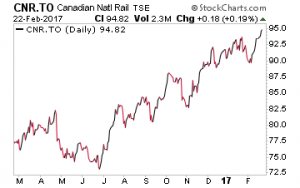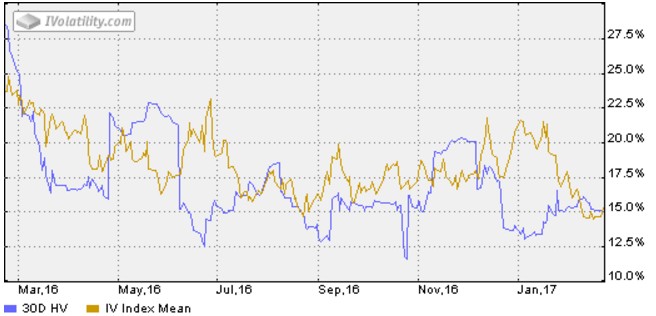A Wall of Worry

There’s an old saying that “markets climb a wall of worry and slide down a slope of hope”. I think many would agree that although both U.S. and Canadian equities continue climb, there’s no shortage of apprehension when discussing how much further the markets can go with out some sort of a correction.
One way to measure the level of fear or complacency in a stock market or individual stock for that matter, is to take a look at the Implied Volatility factored in to its option contract premiums. Implied Volatility is the markets way of measuring risk. Think of the option premium like your car insurance premium. Maintain a clean driving record and your premium remains low, start to demonstrate carelessness by accumulating speeding tickets and other moving violations and your insurance company will increase your premium as you become more of a statistical risk.
Interestingly enough, despite the “speed” of the markets currently, there have been few “moving violations” and as a result the risk premium factored in to the price of options (Implied Volatility) remains at an all time low.
Observing Implied Volatility not only serves as a barometer for market sentiment, it also helps us determine which option strategies make sense under current market conditions.
For example, under this current period of low Implied Volatility, it is more challenging for the option writer to find good call writing and put writing candidates. However, these conditions make it ideal to be an option buyer.
Since I am currently on a train heading to Ottawa, I thought it only fitting that I used Canadian National Railway (CNR.TO)as an example.
Without digging in to the fundamentals, CNR.TO has been on a very impressive trend higher, returning 22% over the last year.
in to the fundamentals, CNR.TO has been on a very impressive trend higher, returning 22% over the last year.
The chart to the left reflects a well defined uptrend that just seemingly wants to keep going. The great thing about the stock market is that there is a place (and a strategy) for all people to test their directional bias…in fact that’s what makes a market. Reviewing the implied volatility of the option contracts can be helpful regardless of what your objectives are.
Let’s first take a look at the Implied Volatility on CNR.TO options. When trying to determine whether options are “expensive” or “cheap” it is helpful to compare the Implied Volatility against the stocks Historic Volatility. Remember, Implied Volatility is pricing in the anticipated move in share prices, while Historic Volatility is a measure of the real movement of the share price over a period of time.
If we take a look at the chart, you will see that Implied Volatility (gold line) is at historical lows. This suggests that options are priced low relative to historical values. This is not surprising, once ag ain, given the fact that the share price has been in a text book uptrend. With that in mind, the information derived from the chart to the right can be useful to investors with 3 differing objectives.
ain, given the fact that the share price has been in a text book uptrend. With that in mind, the information derived from the chart to the right can be useful to investors with 3 differing objectives.
Investor 1, the cautious investor may own the stock and wish to continue to do so. However, they may be concerned that it’s due for a correction. The challenge when buying options for protecting once the share price is already falling is that the premiums increase and become more expensive due to the enhanced risk. It’s kind of like buying flood insurance with a foot of water in your basement. With Implied Volatility being as low as it is, it’s an ideal time to buy put protection.
Investor 2, the bear may be outright bearish the stock. With the current price well exceeding analyst estimates and momentum slowing down, now might be an ideal time to speculate on a pull back. Once again, purchasing a put option to speculate on a sell off when implied volatility is low allows the bearish investor to purchase the contract relatively cheap and benefit from both a drop in share value and increase in implied volatility.
Investor 3, the bull may believe that the stock has a lot further to go, however getting in now might be compared to jumping on to a runaway train (pun intended). The low Implied Volatility environment is beneficial for both put and call buyers. With this in mind, the bullish investor may purchase calls as a stock replacement strategy, limiting the amount of capital outlay and capping the maximum risk to the premium paid. This, in my opinion, is a great way to trade a bullish outlook with a limited risk in a market that continues to climb a wall of worry.
Regardless of your investment objectives or directional bias, ensuring that you have a firm grasp on the concept of Implied Volatility will give you an edge in selecting the most appropriate option strategy given market conditions at the time.
CEO and Director of Business Development
R.N. Croft Financial Group
Jason is CEO and Director of Business Development at R N Croft Financial Group, a member of the Croft Investment Review Committee and a Derivative Market Specialist by designation. In addition, he is an educational consultant for Learn-To-Trade.com and an instructor for the TMX Montreal Exchange.
The information provided on this website, including financial and economic data, quotes and any analysis or interpretation thereof, is provided solely for information purposes and shall not be construed in any jurisdiction as providing any advice or recommendation with respect to the purchase or sale of any derivative instrument, underlying security or any other financial instrument or as providing legal, accounting, tax, financial or investment advice. Bourse de Montréal Inc. recommends that you consult your own advisors in accordance with your needs before making decision to take into account your particular investment objectives, financial situation and individual needs.
All references on this website to specifications, rules and obligations concerning a product are subject to the rules, policies and procedures of Bourse de Montréal Inc. and its clearinghouse, the Canadian Derivatives Clearing Corporation, which prevail over the content of this website. Although care has been taken in the preparation of the documents published on this website, Bourse de Montréal Inc. and/or its affiliates do not guarantee the accuracy or completeness of the information published on this website and reserve the right to amend or review, at any time and without prior notice, the content of these documents. Neither Bourse de Montréal Inc. nor any of its affiliates, directors, officers, employees or agents shall be liable for any damages, losses or costs incurred as a result of any errors or omissions on this website or of the use of or reliance upon any information appearing on this website.
BAX®, CADC®, CGB®, CGF®, CGZ®, LGB®, MX®, OBX®, OGB®, OIS-MX®, ONX®, SCF®, SXA®, SXB®, SXF®, SXH®, SXM®, SXO®, SXY®, and USX® are registered trademarks of the Bourse. OBW™, OBY™, OBZ™, SXK™, SXJ™, SXU™, SXV™, Montréal Exchange and the Montréal Exchange logo are trademarks of the Bourse. All other trademarks used are the property of their respective owners.
© 2024 Bourse de Montréal Inc. All Rights Reserved.
